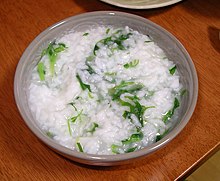Nanakusa
The Festival of the Seven Herbs ( Japanese 七 草 の 節 句 , Nanakusa no sekku , alternatively known as Jinjitsu ( 人日 ) "Human Day") is one of the traditional five seasonal festivals ( 五 節 句 Gosekku ) in Japan.
The name Jinjitsu ("day of mankind") comes from an ancient Chinese custom according to which the first days of each lunar month were assigned to a certain living being that was not allowed to be killed on that day. The first 7 days of the month were the day of the chicken, dog, boar, sheep, cow, horse and finally man. Thus no criminals were executed on the seventh day of the month.
The time of the festival was set in Japan during the Meiji period with the introduction of the solar calendar from the moving day 7 in the lunar calendar to January 7th.
On this day, the traditional custom of eating kayu (rice porridge) with seven herbs ( 七 草 粥 nanakusa-gayu ) exists . The traditional ingredients are seven edible wild herbs that grow in spring:
- Water fennel ( seri , Oenanthe javanica )
- Shepherd's purse herb ( nazuna , Capsella bursa-pastoris )
- Cudweed ( Gogyo , Gnaphalium affine )
- Chickweed ( hakobera , Stellaria media )
- Common Rain Cabbage ( hotokenoza , Lapsana apogonoides )
- Turnip ( Suzuna , Brassica rapa )
- Daikon ( suzushiro , Raphanus sativus )
However, these herbs are replaced with others depending on the regional occurrence of wild herbs.
On the morning of January 7th (or the evening before) you put the Nanakusa , Shamoji (rice spoon) and / or Surikogi (mortar) on the cutting board and declaim: "Before the birds of the continent fly to Japan, let's eat Nanakusa" (also there are different variants).
The custom of eating the 7 herbs has existed in Japan since at least the Heian period . It is said to ensure longevity and health and comes from an ancient Chinese custom that is supposed to avert disaster. Since there is still little green at this time of year, the fresh herbs add color to the table and eating them fits in with the spirit of the New Year. In addition, the rice with the herbs should be good for the stomachs that are often still full from the New Year celebrations .
As a counterpart to the Nanakusa there are the "7 blossoms of autumn":
- Hagi shrub ( hagi , Lespedeza bicolor var.japonica ),
- China reeds ( Obana , Miscanthus sinensis )
- Kudzu ( kuzu , Pueraria lobata )
- Carnation ( nadeshiko , Dianthus superbus var. Longicalycinus ),
- Golden baldrian ( ominaeshi , Patrinia scabiosaefolia ),
- Wasserdost ( fujibakama , Eupatorium fortunei ) and
- Balloon flower ( kikyō , Platycodon grandiflorum ).
These seven autumn flowers are beautiful to look at, their simplicity was greatly admired: they are small and inconspicuous, but very beautifully colored. They are already mentioned as typical autumn flowers in Man'yōshū . However, there is no special festival for them.

